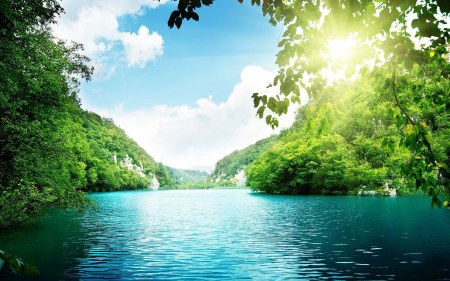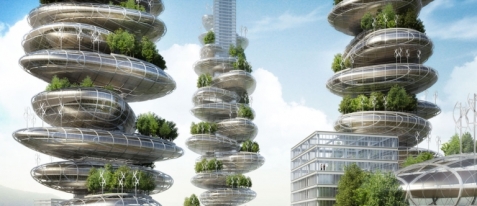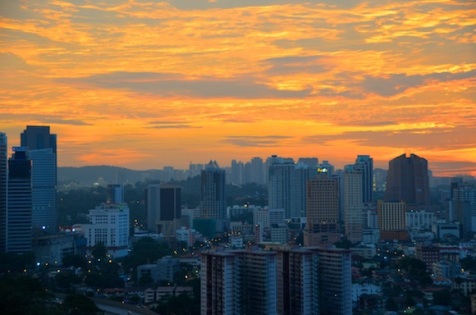By Enrique Lescure
Introduction
The craddle of life on Earth can be said to be found in the blue. For many hundreds of millions of years, the ascending continents of the young planet were as dead and barren as the wastelands of Mars, while the oceans and lakes were teeming with life. Water was the solvent in which the first life-bearing cells emerged during the chaotic epochs after the birth of the Moon.
From a world fraught with volcanic eruptions, a poisonous atmosphere and constant meteor storms, Earth has evolved into a planet able to create complex and beautiful life-forms, forming an ever-changing and ever-evolving biosphere.
Much of the freshwater reservoirs have accumulated during millennia and are ensuring that the plants have enough nourishment to produce and renew soil and to establish the foundations for complex ecosystems to exist within.
Today however, we have destroyed or are on the verge of destroying a third of the world’s freshwater reservoirs. Many regions of the world, such as the Middle East and South America, are already experiencing social upheaval in relation to water depletion. China and India, the two most populous nations on Earth, are also experiencing water depletion on a massive scale.
This presents two kinds of challenges, one which is really long-term and the other which is relatively short-term. The first challenge relates to the fact that in the long-term, depleted freshwater reservoirs create a drier climate, meaning that fewer trees can grow, which leads to soil erosion. 5000 years ago, the Middle East and the Southern Balkans were largely forested regions, which gradually became more and more arid due to massive irrigation projects by city-states and hydraulic empires (aided by climate change).
The same process is repeating today in Brazil, the United States, India, China and Central Europe.
The second challenge is how billions of people in the future should be provided with water for drinking, for hygiene, for cooking and for other activities, while eco-systems should be taken cared of to ensure long-term survivability. This will be one of the most important issues for the Earth Organisation for Sustainability in the future.
Our challenge, as always, is how to be able to weigh the needs of today with what the environment needs in order to stabilise, and how to ensure that communities can participate in this process.
Short Notes (TL;DR)
There is not one singular solution to the challenge of freshwater depletion – rather there must be a transition process which is on-going and is coordinated between five distinct areas. The areas in this regard are all equally important, though emphasis has to be put on different areas depending on the local and regional pecularities of distinct regions of our planet.
~ Short-term solutions, policy-based and social. Rationing, water salvaging, public education regarding water treatment and stimulation of local projects.
~ Medium-term solutions, infrastructure projects, construction of artificial aquifiers, aqueducts and water salvaging plants. Migrations and redistribution of population.
~ Long-term solutions, the creation and re-terraformation of depleted regions by the (re)construction of destroyed eco-systems or new eco-systems. Monitoring of the process.
~ Research, time investments into technologies that can make desalinization more cost-effective, new technologies for recycling and upcycling water quality, reducing the need for water in home appliances and in infrastructure overall.
~ Ensuring the dignity of communities and a fair distribution, namely that the affected populations themselves are having democratic influence in the process of how their transition process should be managed and how much they want to participate in that management.
The future – short-term solutions
We have largely been treating water as if it was air – as if we could use as much as possible of the groundwater and then… well, not having to think about the management. Sure, in most developed nations, there is water management, which works more or less well (the Nordic countries are generally very high up on that scale, with drinkable tap water and very large and unspoiled reserves of ground water, with hundreds of thousands of lakes).
In the future, there is a profound risk that we – at least in some regions – would have to treat water in a way similar to how we would endure on a Mars base, namely by careful management and a circular hydraulic economy, where water is moved from household appliances and infrastructure to large aquaponics facilities, where rainwater is gathered, filtered and cleaned and utilised within the habitat, with zero to little usage of aquifiers. In fact, we should move towards minimising our usage of groundwater, instead focusing on water recycling, rainwater usage, water from rivers (though we should be careful with river water as well and have systems that can replenish the water to the rivers from the base). ![]() Urine may have to be filtered and turned into drinkable water again.
Urine may have to be filtered and turned into drinkable water again.
In terms of personal usage, this would probably entail local water regulations where people are given either a water quota for a community tank, or their own individual tanks where they could use water. A lot of the functions that today are individually allocated might have to become communal, like washing clothes, bathrooms, kitchens and so on. When two or more distinct communities are sharing the same source for their water, there needs to be a form of common management or at least transparency and concord between these two communities, thence holons should be formed for these tasks.
Ensuring human survival – Medium-term solutions
In particular cases, there might be needs to transport water from either deep aquifiers (like the Sahara aquifier) or from regions with abundant water reserves to regions where water shortage threatens the survival of hundreds of millions, and can cause the collapse of over-stressed communities. This can be achieved through the construction of closed aqueducts or water pipelines, and must be managed both by a convent of representatives of the affected communities, and a technical authority managing the infrastructure of such projects. In some cases, the Earth itself may have to be transformed to construct fresh-water lakes with adjacent forest eco-systems to form the basis of medium-term water sustainability in the social term.
Or, we might even need to consider large-scale migrations, for example from the United States into Canada, from China into Siberia and from the Mediterranean countries into north-eastern Europe, in order to alleviate the resource stress on China and the US by distributing the population more evenly, as the polar regions become more habitable due to climate change while the temperate regions become less able to provide for their population. This would also reduce the need to transport water from the north to the south, by instead making it possible for people to migrate from the south to the north.
Another project worth considering is to create closed-loop rivers in Sahara and then form communities around them, where people from Africa and parts of the Middle East (and even from flooded Islands like the Maldives) can settle, in oasis city states built alongst a string of pearls in the vast Saharan desert.
Lastly, the final two areas for human resettlement are Antarctica and the Oceans, and both represent technological challenges in terms of how to attain enough water to supply significant populations.
Ensuring the well-being of the Biosphere – Long-term solutions
When we in the EOS are talking about long-term solutions, we mean long-term, in terms of 10.000-50.000 years. This means partially that humans would have to live in different forms of communities. Mega-cities housing tens of millions of people should not be subsidized as an ideal form of life, which they are in today’s exponential growth-oriented model. Neither would a massive, evened-out distribution of the population be a good solution, since it would wipe out forests and eco-systems. The ideal would be concentrated inter-linked communities ranging in the thousands, though there would be no forced population redistribution.
The first thing that needs to be done is to ensure that our biological waste is used to renew soil cultures, or to build new soil cultures where old ones have been depleted. This means that we should not put our waste in the oceans or in lakes, but instead use human manure as a valuable resource to be utilized as a part of recreating and strengthening soil quality. What we term as waste from mines can also be valuable, since rock often contains important resources that increases the nutrition levels.
We need to ensure to reduce soil erosion, both by the construction of terraces and especially by the growing of plants, allowing eco-systems to take hold. We need to move away from mono-cultures and grow food more vertically and within the confinements of urban centres. Of course, it is not possible to remove all mono-cultures, but we need to reduce the amount significantly over a long span of time.
If we cannot reestablish eco-systems that have been lost, we must see whether we can build new eco-systems to compensate for the lost ones, and if these new eco-systems would have a positive impact on the Earth’s biosphere.
And – a lot of this means that we have to create more preserves where human-oriented activities are minimised, and that we let these preserves be untouched for hundreds of generations, that said – until a new equilibrium is established.
Applying and multiplying knowledge – Research
There is much valuable research done today within the space industry, regarding the effective usage of water in order to create self-containing artificial eco-systems and provide food on space stations or on Mars bases. This technology can also be applied on the Earth in order to salvage resources and increase our resilience. However, the technology needs to become more energy efficient and as ecological as possible without compromising the values behind. The things envisioned to be used one day on Mars should also be utilised in villages in Morocco, Honduras or Kerala, and thus the knowledge must spread horizontally in an exponential manner (there can EOS be of immeasurable help, by providing educational programmes aimed towards local communities).
Desalinization should also be investigated, and an emphasis should be put on making the process cleaner, more effective and cheaper in terms of resources and construction. Especially within small-scale appliances, a focus should be made, so that every home in a community can contribute to the process of turning saline water into freshwater.
A third area is in terms of the development of household machines that use less water, either by design features or by the usage of more advanced technology, for example smaller treatment plants and the integration of treatment plant infrastructure into the modular features of future homes. To this we can also add technologies that can treat infected water and clean it.
Lastly, we should not omit to mention the integrated features of intelligent cities, which can be used to predict the usage of water over long-term and come with proposals over how water management should be carried out.
Including the communities – the social aspect
An integral part of what we in EOS are striving to create, is that people locally and regionally should be able to exert influence over their own destinies. This does not only mean to guarantee the protection of individual rights – both through a Constitution and through giving individuals the means to defend their autonomy – but also the protection of the rights of communities. An important aspect of this is that communities should bear the responsibility of the natural resources within their area – including water.
This can be problematic though, because the irresponsible usage of natural resources is a great part of what is wrecking our biosphere right now and causing the Sixth Mass Extinction. Therefore, there is a balance between the democratic autonomy of a community and their right to exert the main part of the influence on how natural resources should be used locally, and the rights of the Biosphere to exist and prosper.
There is no fixed answer on how to resolve this potential conflict, but every local area is unique. What is important however is to identify needs, to establish a dialogue with the local community, to create management plans together with representatives of the local community, both political leaders, traditional leaders, economic actors, representatives of the civil society and the general public, and to include them in the process where holons are established to oversee aspects and manage aspects of the hydraulic infrastructure. The grade and depth of the management and the collaboration will vary between regions and areas.
This also includes the right for the local area or region to withdraw from the cooperation or renegotiate. However, what we need to establish is a consensus and an awareness of how water usage affects the environment and how a changed environment will affect the future of local communities. Thus, EOS needs to act primarily as an educational organisation, while we need to incorporate the knowledge and wisdom of local communities and understand that situations need to be addressed with a sensitivity to the values and norms – in order to be able to canalise the force of the community towards the gathering of new knowledge that can be utilised to improve water management.
Summary
Some new age spiritualists are claiming that we will soon enter the age of Aquarius, or that we have already. Aquarius as a symbolic figure is a human being that pours water – enlightenment – over humanity. It can be seen as an appropriate metaphor in one way, because if the knowledge of how much we have damaged our water reservoirs was better known, there would be a greater movement towards solving these problems.
Some aspects of the article you have read may seem rather radical. The problem however is that the more we are stressing and depleting the reservoirs of water and soil needed to sustain a complex land-based supra-civilization as present-day humanity, the more radical the solutions would eventually have to be.
The important thing to remember is that interventions must happen with the permission and active participation of local communities, and that they should interfere as much as necessary but not more into the livelihood of the people. Interventions can be intrusive, so therefore the most essential part of any transition is that the population is made aware of the nature of the situation, that the population is prepared for when interventions would happen and how far they will go, and that the public can affect the process and partake in it.
Water must be managed in an ecological manner, but it must ultimately also be managed by the people.



















